Malaysia
Background
Sandwiched between Thailand and the northern fringes of Indonesia, Malaysia and Singapore are in an altogether higher economic bracket than the rest of Southeast Asia.
Malaysia comprises the lower half of the Malay peninsular to the south of Thailand, as well as the states of Sarawak and Sabah in the north of Borneo. Singapore is tucked in at the far south of the peninsular.
The modern reality of these two states is far removed from the "boy's own" images of rubber planters, steaming jungle, heroes like Raffles and Wallace, and the stories of Conrad and Maugham. On equal economic terms with the West, both Singapore and Malaysia have long been recognised by the United Nations as "first world" countries, with an average per capita income comparable, and in some cases exceeding, European nations.
Kuala Lumpur, Malaysia's capital, is now a flashy modern city of high-rises and higher incomes, more Middle Eastern than Asian, although there are still remnants of its exotic past, particularly in Chinatown.
Although this is Asia in the fast lane, it is still possible to encounter nature in the raw -- in the virgin rainforests of the national parks, or indigenous groups in the highlands. Peninsular Malaysia's east coast is less developed than the west and turtles still visit the far north east to lay their eggs.
Highlights
Kuala Lumpur
At the turn of the century Kuala Lumpur was a shanty tin-mining town at the confluence of two rivers. In 1880 the British moved the Residency Administrative Centre from Klang to Kuala Lumpur, demolishing the shanty housing and rebuilding in brick with wide streets.
The Moorish style railway station was built in 1910, by which time the population had risen ten-fold, with a high Chinese percentage. Kuala Lumpur is now a congested modern capital, with high-rise developments and few traces of its colonial past.
Sarawak
The "land of the hornbill", Sarawak is a Malaysian territory at the north of Borneo. Charles Darwin described it as "one great wild untidy luxuriant hothouse made by nature for herself." In 1932, Patrick Synge wrote "as we moved slowly upriver Sarawak's forests were like a ... dream of abundance, beauty, and peace but also of mystery alive behind the wall'. Sarawak has a swampy coastal plain and rugged jungle-clad mountains in the interior.
The population is 1.5 million, most of whom live along the rivers. Thirty percent are Iban tribes people, also called sea dayaks; once the keenest of the head hunters, many still live in traditional longhouses. Of the rest of the population 30% are Chinese, 20% Malay, while smaller indigenous tribes account for the remainder. Sarawak is fascinating ethnically, but transport and travel are still difficult to the interior.
Sabah
The name may come from the Arabic word meaning "the land below the wind." Wallace recorded that "everywhere is covered with interminable forest", but sadly this is no longer the case. Logging has caused a tremendous loss of biodiversity, as well as the squandering of a great natural resource.
Out of its population of 1.4 million, about half are illegal, mainly Filipino, immigrants. Sabah is about the size of Ireland and has a lively political scene.
There are some 30 different tribes, speaking 50 languages. The tribes are divided into three main groups: Kadazan, Murut and Bajau.
The Kadazan are renowned for their gentleness and honesty -- they are farmers and mainly rice producers.
The Bajau are the "cowboys of the wild east" and also paradoxically the "sea gypsies", infamous as feared pirates.
The Murut meanwhile are shifting cultivators, who live in longhouses and are known for their weaving, basketry, rice wine and dancing -- they were also the last tribe to relinquish head hunting.
The pride of Sabah is the great mountain Mt Kinabalu, at 4,101m it is not quite the highest mountain in SE Asia, beaten by the mighty Puncak Jaya in Indonesia, but is nevertheless most impressive and in fact is still growing at a rate of 5cm a year.
Beaches
Most developed beaches are found on the peninsular, both east and west coasts. Island resorts off the west coast include Pulau Pangkor, Pangkor Laut with its exquisite Emerald Bay, and Pulau Langkawi with its surrounding islands in the north.
On the east coast is Pulau Rawa, an island off Mersing, and the beaches near Kuantan on the South China Sea. Merang has a white sandy beach and there are numerous islands offshore along this coast.




